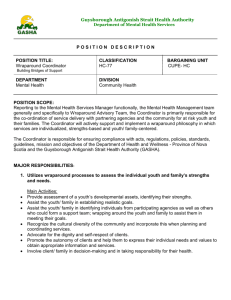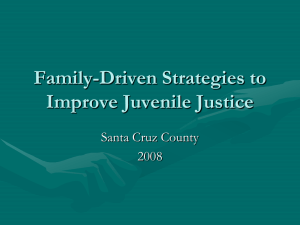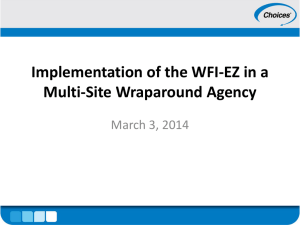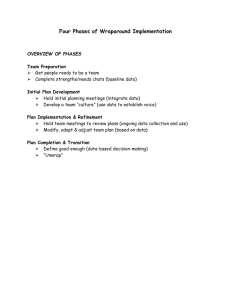Wraparound Evidence Base
advertisement
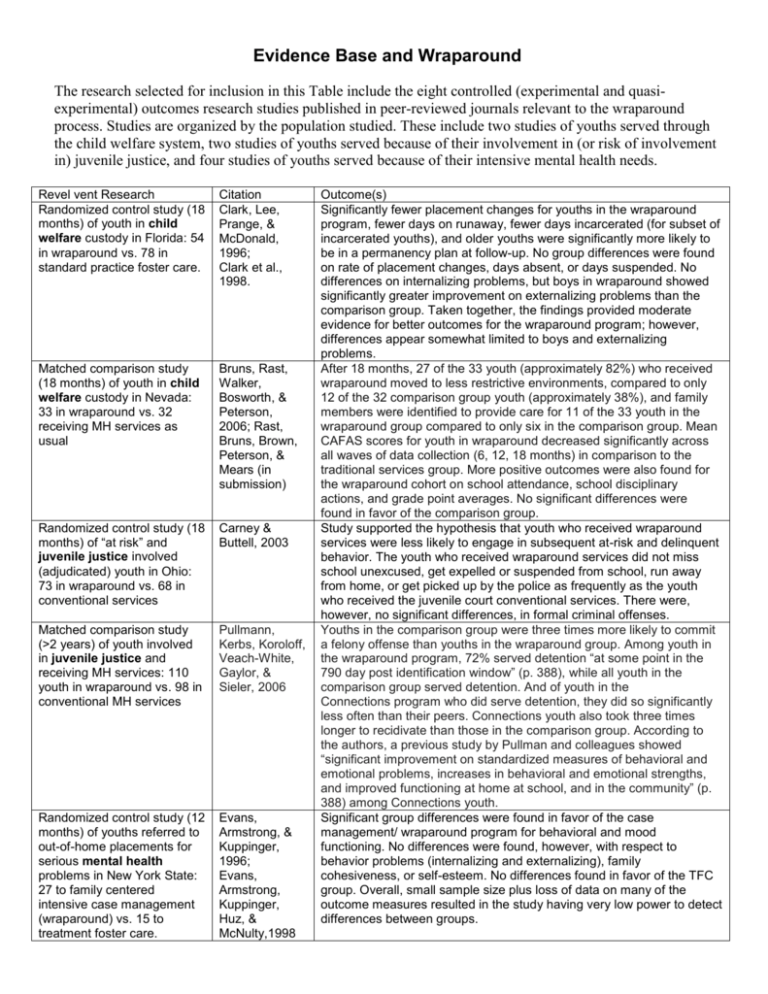
Evidence Base and Wraparound The research selected for inclusion in this Table include the eight controlled (experimental and quasiexperimental) outcomes research studies published in peer-reviewed journals relevant to the wraparound process. Studies are organized by the population studied. These include two studies of youths served through the child welfare system, two studies of youths served because of their involvement in (or risk of involvement in) juvenile justice, and four studies of youths served because of their intensive mental health needs. Revel vent Research Randomized control study (18 months) of youth in child welfare custody in Florida: 54 in wraparound vs. 78 in standard practice foster care. Citation Clark, Lee, Prange, & McDonald, 1996; Clark et al., 1998. Matched comparison study (18 months) of youth in child welfare custody in Nevada: 33 in wraparound vs. 32 receiving MH services as usual Bruns, Rast, Walker, Bosworth, & Peterson, 2006; Rast, Bruns, Brown, Peterson, & Mears (in submission) Randomized control study (18 months) of “at risk” and juvenile justice involved (adjudicated) youth in Ohio: 73 in wraparound vs. 68 in conventional services Carney & Buttell, 2003 Matched comparison study (>2 years) of youth involved in juvenile justice and receiving MH services: 110 youth in wraparound vs. 98 in conventional MH services Pullmann, Kerbs, Koroloff, Veach-White, Gaylor, & Sieler, 2006 Randomized control study (12 months) of youths referred to out-of-home placements for serious mental health problems in New York State: 27 to family centered intensive case management (wraparound) vs. 15 to treatment foster care. Evans, Armstrong, & Kuppinger, 1996; Evans, Armstrong, Kuppinger, Huz, & McNulty,1998 Outcome(s) Significantly fewer placement changes for youths in the wraparound program, fewer days on runaway, fewer days incarcerated (for subset of incarcerated youths), and older youths were significantly more likely to be in a permanency plan at follow-up. No group differences were found on rate of placement changes, days absent, or days suspended. No differences on internalizing problems, but boys in wraparound showed significantly greater improvement on externalizing problems than the comparison group. Taken together, the findings provided moderate evidence for better outcomes for the wraparound program; however, differences appear somewhat limited to boys and externalizing problems. After 18 months, 27 of the 33 youth (approximately 82%) who received wraparound moved to less restrictive environments, compared to only 12 of the 32 comparison group youth (approximately 38%), and family members were identified to provide care for 11 of the 33 youth in the wraparound group compared to only six in the comparison group. Mean CAFAS scores for youth in wraparound decreased significantly across all waves of data collection (6, 12, 18 months) in comparison to the traditional services group. More positive outcomes were also found for the wraparound cohort on school attendance, school disciplinary actions, and grade point averages. No significant differences were found in favor of the comparison group. Study supported the hypothesis that youth who received wraparound services were less likely to engage in subsequent at-risk and delinquent behavior. The youth who received wraparound services did not miss school unexcused, get expelled or suspended from school, run away from home, or get picked up by the police as frequently as the youth who received the juvenile court conventional services. There were, however, no significant differences, in formal criminal offenses. Youths in the comparison group were three times more likely to commit a felony offense than youths in the wraparound group. Among youth in the wraparound program, 72% served detention “at some point in the 790 day post identification window” (p. 388), while all youth in the comparison group served detention. And of youth in the Connections program who did serve detention, they did so significantly less often than their peers. Connections youth also took three times longer to recidivate than those in the comparison group. According to the authors, a previous study by Pullman and colleagues showed “significant improvement on standardized measures of behavioral and emotional problems, increases in behavioral and emotional strengths, and improved functioning at home at school, and in the community” (p. 388) among Connections youth. Significant group differences were found in favor of the case management/ wraparound program for behavioral and mood functioning. No differences were found, however, with respect to behavior problems (internalizing and externalizing), family cohesiveness, or self-esteem. No differences found in favor of the TFC group. Overall, small sample size plus loss of data on many of the outcome measures resulted in the study having very low power to detect differences between groups. Quasi-experimental (6 months) study in Department of Defense demonstration site of youths with serious mental health issues: 71 in wraparound group vs. 40 in comparison group (study refusers/ineligible youths). Bickman, Smith, Lambert, & Andrade, 2003 Quasi-experimental (24 months) study of youths with serious mental health issues in urban Baltimore: 45 returned or diverted from residential care to wraparound vs. 24 comparison. Hyde, Burchard, & Woodworth, 1996 Quasi-experimental (multiplebaseline case study) of four youths referred to wraparound because of serious mental health issues in rural Michigan. Myaard, Crawford, Jackson, & Alessi (2000). Findings included higher utilization of “wraparound services” (e.g., case management, in-home supports, and nontraditional services) for the demonstration group, higher costs for the demonstration group (primarily due to this group remaining in treatment longer), and no consistent differences between the groups on outcome measures (e.g., behavior, functioning, caregiver strain, perceived social support, family environment). Limitations of this study include the short time span (6 months) and whether the demonstration project truly followed the wraparound process. Authors stated the “wrap” condition had access to informal services and flexible funding, but authors did not assess “wrapness” and stated that, “there is no evidence that the content or the quality of the services were different for the Wraparound children.” (p.151) Primary outcome was a single rating that combined several indicators: restrictiveness of youth living situation, school attendance, job/job training attendance, and serious problem behaviors. Youths received ratings of “good” if they were living in regular community placements, attending school and/or working for the majority of the week, and had fewer than three days of serious behavior problems during the course of previous month. At 2-year follow-up, 47% of the wraparound groups received a rating of good, compared to 8% of youths in traditional MH services. Limitations of the study include study attrition and group nonequivalence at baseline. The multiple baseline case study design was used to evaluate the impact of wraparound by assessing whether outcome change occurred with (and only with) the introduction of wraparound at different points in time. The authors tracked occurrence of five behaviors (compliance, peer interactions, physical aggression, alcohol and drug use, and extreme verbal abuse) for each of the youths. Participants began receiving wraparound after 12, 15, 19, and 22 weeks. For all four participants, on all five behaviors, dramatic improvements occurred immediately following the introduction of wraparound. References Bickman, L., Smith, C., Lambert, E. W., & Andrade, A. R. (2003). Evaluation of a congressionally mandated wraparound demonstration. Journal of Child & Family Studies, 12, 135-156. Bruns, E.J., Rast, J., Walker, J.S., Peterson, C.R., & Bosworth, J. (2006). Spreadsheets, service providers, and the statehouse: Using data and the wraparound process to reform systems for children and families. American Journal of Community Psychology, 38, 201-212. Carney, M. M., & Buttell, F. (2003). Reducing juvenile recidivism: Evaluating the wraparound services model. Research on Social Work Practice, 13, 551-568. Clark, H.B., Lee, B., Prange, M.E. & McDonald, B.A. (1996).Children lost within the foster care system: Can wraparound service strategies improve placement outcomes? Journal of Child and Family Studies, 5, 39-54. Clark, H. B., Prange, M. E., Lee, B., Stewart, E. S., McDonald, B. B., & Boyd, L. A. (1998). An individualized wraparound process for children in foster care with emotional/behavioral disturbances: Follow-up findings and implications from a controlled study. In M. H. Epstein, K. Kutash & A. Duchnowski (Eds.), Outcomes for children and youth with emotional and behavioral disorders and their families: Programs and evaluation best practices (pp. 513-542). Austin, TX: Pro-ED, Inc. Evans, M.E., Armstrong, M.I., Kuppinger, A.D. (1996). Family-Centered Intensive Case Management: A Step Toward Understanding Individualized Care. Journal of Child and Family Studies, 5, 55-65. Evans, M. E., Armstrong, M. I., Kuppinger, A. D., Huz, S., & McNulty, T. L. (1998). Preliminary outcomes of an experimental study comparing treatment foster care and family-centered intensive case management. In Epstein, M.H. (Ed); Kutash, K (Ed); et al. (1998). Outcomes for children and youth with emotional and behavioral disorders and their families: Programs and evaluation best practices. (pp. 543-580). Xviii, 738 pp. Hyde, K. L., Burchard, J. D., & Woodworth, K. (1996). Wrapping services in an urban setting. Journal of Child & Family Studies, 5(1), 67-82. Myaard, M. J., Crawford, C., Jackson, M., & Alessi, G. (2000). Applying behavior analysis within the wraparound process: A multiple baseline study. Journal of Emotional & Behavioral Disorders, 8, 216229. Pullmann, M. D., Kerbs, J., Koroloff , N., Veach-White, E., Gaylor, R., & Sieler, D. (2006). Juvenile offenders with mental health needs: Reducing recidivism using wraparound. Crime and Delinquency, 52, 375397. Rast, J., Bruns, E.J., Brown, E.C., Peterson, C.R., & Mears, S.L. (submitted May 2007). Impact of the wraparound process in a child welfare system: Results of a matched comparison study. Social Work Research.

